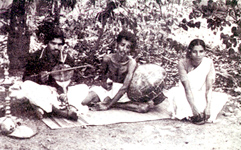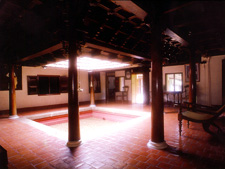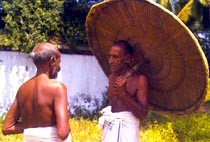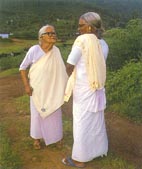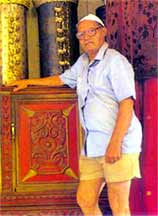| Tobacco-free district | |
|
Monday, September 29, 2008
Kottayam declared as the first tobacco-free district in the country
Thursday, September 25, 2008
Onam: Story of Aryan – Dravidian conflict.
Gurukul Colege is celebrating Onam on September 26th.2008, for convenience, though Thiruonam has been already celebrated on September 12th. There are several stories about Onam:
There is a little tradition of Onam known only in Onattukara, the land of Onam, areas in and around Mavelikara (land of Maveli or Mahabali). The little tradition is that Maveli has been a Buddhist King of Onattukara, where even today remnants of Buddhist culture is present. However, the more popular tradition is that Mahabali has been an Asura (demonized!) King who could not keep the promise he made to Vamana, the incarnation of Vishnu. He was therefore sent to Patala, the netherworld, from where he was permitted by Vishnu to visit his former subjects on the day of Thiruonam. in Chingam, the first month of the Malayalam Era. Only in Thrikkakara, near Kochi, which the earliest stronghold of Brahminism inKerala, Vamana is worshipped. In Sabarimala, which has Buddhist links, Onam is celebrated with Palapayasam., a popular Onam delicacy prepared with rice and milk. The word Onam itself might have derived from annam, rice, and oonu or onavakam (Tamil), a rice meal, a feast. In most places it is a secular harvest festival, unrelated to any temple ritual.
Maha Bali, a mighty prince, symbolizes Great Sacrifice. He has performed a Great sacrifice for his country and in turn had to sacrifice his own life for the values he held dear. He was an ideal king under whose rule there was utmost peace and justice, without any corruption or discrimination, everyone enjoying freedom. Kerala Christianity which has also got Buddhist connection refers to the Holy Communion, Qurbana, as Great Scrifice, Bali. The title of the great Chera King who abdicated his throne is Perumal, an allusion to Greatness. Cheras, the princes of the Cheramar tribe who were the indegenous people of Kerala, whose descendents are now known as Kuravas, most probably contributed Kerala its name. Certainly the story of Onam, the great feast, is a remembrance of a life of freedom and plenty.
Little Tradition of Onattukara
A different tradition of Onam is known in and around Onattuakara which includes the present Kayamkulam, Karunagappaly Mavelikara taluks. This local little tradition gives much light to what makes Onam memorable. Onattukara means the land of Onam. Mavelikara means the land of Maveli, the more popular shortened form of the name, Mahabali. Maveli was the king of Onattukara. Mahabali was a Buddhist King. Even now the remnants of Buddhist culture is present in Mavelikara and nearby places. Bali, Palli, Maha, katha and several other Malyalam words come from Pali, the pre-Sanskrit (prakrit) language of Jainism and Buddhism. It is to be noted that Christians and Muslims in Kerala, who were converted from Buddhism when it declined at the hands of Vedic revivalists like Sankaraharya, called their worship places Palli. Christians call their central religious ritual, Qurbana, as the great self-sacrifice, Maha Bali. Bali is the sacrifice of a great King. Several important princes of ancient mythologies were were known as Balis (Bali who saved a dove by offfering the vulture meat from his own thigh, and Bahubali, the great Jain Prince of Sravanabalgola.), This liitle tradition, probably comes from the Kerala's Buddhist past, tells that Sabarimala Sasta, the most important deity in Kerala, has been a Buddhist prince, who later turned out to be an incarnation of Vishnu. Even Buddha, who taught atheism, himself was made into an incarnation of Vishnu. The seated Buddha statue outside the Mavlikara Temple resembles the Sasta of Sabarimala. The sitting posture of Sabraimal Sasta is undoubtedly a Buddhist Lotus posture. The special chantings during the pilgrimage to Sabarimala also resemble the Buddhist Saranam chants. (compare the Budham Sarnam, Sanghom Saranam, Dharmam Saranam chants with the Swami Saranam, Ayyappa Saranam of Sabarimal pilgrims. More over the earliest reference to Onama celebration come around AD 800 after the decline of Sanghom period in South India. This also marks the time of the resurgence of Hinduism under Sankarachaya. Hence for all probablity Onam is the celebration of the ideal rule of a Dalit indigenousBuddhist King of Kerala who was defeated by the Aryans. The only Vamanamurthy temple in Kerala is in Thrikkakara, near Cochin, probably the earliest Brahmin settlement in Kerala. Two of the most prominent events in Kerala, Onam as well as Sabarimala pilgrimage, are associated with Kerala's Buddhist pastand are observed by people of all religious traditions. Onam celebrates the return of the good King who established a Kingdom with justice and equality as the corner stones, and sacrificed his life, emptied his power and authority and descended to hell (pathala) and comes again to see his people; something which the Christians are also proclaiming as the truth of Christ.
Kashyapa had two wives, Diti and Aditi, who were the parents of demons and demigods (Asuras and Devas) respectively. Indra, the king of demigods, went to war with the king of Asuras. Mahabali, the King of Asuras, defeated Indra and proceeded to occupy Indra's territory. Kashyapa, who had gone to the Himalayas to do penance, on his return found Aditi weeping over the defeat of her son, Indra. By divine insight, Kashyapa recognised the cause of grief. Kashyapa tried to console Aditi who was wailing in grief, saying that nothing happens in the world without God's will and people should go on doing their duties. Kashyapa asked Aditi to pray to Lord Narayana and taught her Payovrata, a ritual that has to be observed from the 12th day of the bright half of Karthika(Sukla-paksha Dvadasi). Since Aditi carried out the Vrata with a pious heart, Lord Narayana appeared before her and informed her that he would himself place a child in her womb and help Indra. Later, on the 12th day of the bright half of the month of Bhadrapada,Aditi gave birth to a son of uncommon effulgence. That child, "Vamana-murti", demonstrated his divine powers by doing marvellous deeds even when he was a child.
Balichakravarthi (Bali, The Emperor) or Mahabali, was the grandson of Prahlad (son of Hiranyakashipu who met Vishnu in hisNarasimha Avatar. Prahalad, despite being an Asura, had great faith in Vishnu. One cannot miss the series of warfare between Vishnu and the Asuras - those born of the breath of God. Bali Maharaj, sat in Prahlad's lap as a child and learnt love and devotion of Lord Vishnu from Prahlad.
Mahabali's rule was considered as the golden era of Kerala. The celebration of Onam resounds and chants the following song all over Kerala:
| “ | When Maveli, our King, ruled the land, All the people had equality. | ” |
The gods were very annoyed as Bali became the ruler of all the three worlds having defeated the Devas. Violence was inflicted upon the Devas.[1] The gods approached Vishnu and asked for his help them. Mahabali, who was performing the sacrificial rite of Viswajith Yagna or Aswamedha Yagna[2] on the banks of Narmada River, declared that he would give anything that anyone sought from him during this Yagna. He Vishnu, incarnated in the form of Vamana, a dwarf to defeat the Daityas.
Vamana came to the Yaga-shala. As he was approaching them, the sages assembled there perceived the extraordinary effulgence form of the young lad. Mahabali went forth to receive the Brahmin boy with all traditional honours and gave him an eminent seat befitting the status of a holy person. Bali with the usual courtesy given to the people who come to ask for help told him Master! It is my good fortune that you have chosen to honour me with your presence. Whatever you desire, I am here ready to fulfill the same. Vamana smiled and said: "You need not give me anything great. It is enough if you give me that extend of land covered by three footsteps of mine".
On hearing him, Bali's preceptor, the Brahmin Shukracharya (a Daitya priest) who had vision of the future told Bali that the one, who had come to take alms from Bali was not an ordinary Brahmin but Lord Narayana Himself who had assumed this form. He advised Bali not to promise the lad anything. But Bali was a king who would never go back on his word. He told his Guru that he would never break his promise as it was a sin. Shukracharya insisted that he should not fulfill the demand of Vamana as he had come to deprive Bali of all his possessions.
Bali, however, was determined to honour the word given to Vamana, begged pardon of his Guru for disregarding his advice. Earlier, while Bali was embarking on the war with Indra, he had prostrated at the feet of his preceptor, Shukracharya, and on his advice he performed the Vishwajit Yagna from which he secured very powerful weapons. It was only because of Shukracharya's help that he was able to conquer Indra. On this occasion, Bali was not prepared to heed the advice of the same preceptor. Shukracharya cursed Bali, saying: 'As you have not heeded your Guru's words, you will be reduced to ashes'. Bali was firm and replied: 'I am prepared to face any consequence but will not go back on my word'.
Saying so, he asked Vamana to measure the three feet of land as desired by him. All attempts of Shukracharya to dissuade Bali from offering the land desired by Vamana proved futile. Bali considered everyone who came to him as god himself and never refused anyone anything that they have asked. Bali told his Guru: "Prana (life) and Maana (honour) are like the two eyes of a person. Even if life goes, honour should be protected. Knowing that the person that has come now is the Lord Himself, I should be the most fortunate one as the Lord, who gives everything to mankind, is seeking something from me." Bali boasted that even in Vishnu himself were to come to his sacrifice and ask for anything, Bali would deliver it.[3]
Vamana grew in size until he towered above the heavens. With one foot, he measured all of the earth. With the other, he claimed all of the heaven. There was still one foot of territory that Bali owed him. Bali asked to place the final step on his head as the third step of land which Lord Vamana had asked for as alms. Vamana placed the third step on the head of Bali and suppressed him to Patala, the underworld. For the devotion of this Daitya Mahabali, Lord Vishnu (Vamana) granted him rule over Patala. Vamana aka Vishnu granted Bali the boon that he would hold the position of Indra for one Manvantara , thus fulfilling his devotee's desire ( the office of Indra being a rotating position , changing every Manvantara ) .
As a last wish Mahabali was granted the permission to visit his subjects once a year. Thus, Keralites celebrate Onam festival to commemorate the memory of a Great King Mahabaliwho would keep his promise. Mahabali fulfilled his name as the great martyr for the sake of Truth ("Satya"). The name "Mahabali" itself means Great Sacrifice.
During Onam, the feast and festive mood of the people, dressed in their best, is considered reminiscent of the prosperous and truthful life of the subjects during Bali's flawless reign. People wear new clothes (Vastra) during Onam. The 'Vastra' also stands for heart. Thus the significance of wearing new clothes is about making the heart new by removing all bad thoughts and feelings. People forgetting their sectarian outlooks, join together to welcome the auspicious 'Thiruvonam' day. more
Kerala Government website describes Onam as a Vaishnavite festival
The loss of political unity did not lead to the loss of political independence in Kerala during the fag end of 14th century. The ghost of the Chera kingdom haunted the destiny of Kerala as a guardian deity for many centuries to come. Each minor chieftain claimed the gift of the last Cheraman Perumal as the sanction behind his throne. It was essentially a game of power politics.
Within a generation of the decline of Chera power, the governors of Eranad shifted from their interior headquarters at Nediyiruppu to the coastal strip of Kozhikkod. Gradually, the Eradis(rulers of Eranad), now known to the world better as the Zamorins of Kozhikkod, grew in prosperity and power. The locational advantage enjoyed by their new headquarters with its proximity to Kozhikkod was a decisive factor in attracting a growing number of Arab traders. The rulers also exhibited a measure of statesmanship in quarantining religious tolerance to all sects and creeds in the big international mart at Kozhikkod. In due course, they roped in the chieftains of Parappanad and Vettattunad in the south as well as Kurumbanad and Puranad (Kottayam) in the north, within their sphere of influence.
Post Chera Period
The post Chera period witnessed a gradual decadence of the Namboothiris, until by about the 16th century, they put of their affairs in the hands of their Nair secretaries. A Namboothiri - Nair alliance came into being.
Another feature of this period was the widening gulf between the Namboothiri - Nair upper class and the Thiyya - Pulaya lower class. In order to accommodate the class differences properly, the four - fold caste system came to be sub-divided with infinite gradations, based on real occupation, habitat and political influence. New dimensions were invented and added on to the scale of unapproachability and unperceivability.
With increasing rigidity of caste, the worst sufferers were the Parayar, Pulayar, Cheramar, etc. They were attached to plots of cultivable land and unceremoniously exchanged along with the plots without any right to family or children. This feudal society, however, was prosperous and complacent. With agricultural and commercial prosperity on the increase, festivals like Onam and Vishu, which began as mere sectarian religious observances, acquired the character of popular celebrations. They were fixed up at a time when the tenants had to pay their feudal dues to the owners of land. The enthusiasm of the tenants transformed Onam, a Vaishnava sacred day commemorating the Vamana incarnation, into a harvest festival.
Link
show details Sep 13, 2008 |
Dr. D. Babu Paul wrote:
Happy Onam! - Looking at Mahabali from a different angle?
Another year and another Onam. The most reassuring thing about Onam
is that it is one festival that is common to all. Nobody has tried to
hijack it. Well, no religious fundamentalist has taken to it, for or
against. Ashtami Rohini and Vinayaka Chaturthi were observed by us
without branding them exclusive. However people started projecting
these festivals to foster religious sentiments. So too Christmas and
Good Friday being taken to streets. And Ramadan is no exception.
These are seen as occasions to assert identity. Onam fortunately is
free from such religious identities despite the Thrikkakkara concept.
Yet Onam has been hijacked too. By commercial interests. They try to
convert this as the great shopping season of Kerala. Newspapers vie
with one another to produce two dailies daily (which means two front
pages but for advertisements two full back pages too!) and special
pull-outs and marketing supplements extra. The net result is that the
village familiarity has been replaced by the commercial and selfish
tones of the marketplace. When I was young we in the village moved
from one house to the next, collecting whatever flowers were
available, and then laid out a pookalam sometimes in the village
square (big boys a.k.a. chettans), sometimes in some tharawad (mainly
chechis), and occasionally as mobile ones, today in Ramu's courtyard
and tomorrow in John's. What mattered was the sense of camaraderie
and oneness. I do not know whether back in my village in Ernakulam
district the ambience still lives on. I cannot find any sign of such
continuity in the rural areas surrounding the capital here.
Onam is celebrated as a Kerala festival. If it is commemorating an
event in Kerala Vamanan is an anachronism unless you rule out the
Parasurama legend. Legend has it that Kerala was reclaimed by Lord
Parasurama, one of the ten incarnations of Mahavishnu. If we accept
that we must also concede that a king who ruled Kerala could not have
been vanquished by another earlier incarnation called Vamanan. My own
guess is that Mahabali was never King of Kerala. According to
Bhagavatam Mahabali conducted his yajna on the banks of Narmada when
he was accosted by Vamanan. It is well known that there were Brahmin
migrations from the north to Kerala. These were perhaps Gowda
Saraswats or other Saraswats or Nampoothiries. These migrants would
have carried the story with them and over many generations the story
may have got embellished and edited to its present form. This
argument would at least take care of the problem of anachronism!
Who was Mahabali? Mahabali was an Asura King who conquered our earth,
Bhoolokam, and the heavens, Devalokam. And Vamanan staged a bloodless
anti-imperialist coup by which he sent away the king of the
netherworld to rule there while at the same time generously granting
a multiple entry visitor's visa to come back once a year for a few
days. If you analyse Mahabali's career and character you will find no
reason to be apologetic about the role of Vamanan who like Mahatmaji
much later forced a peaceful exit of a conqueror.
Mahabali was not merely an ambitious conqueror. He was an arrogant
and presumptuous personality too. He was so full of pride that he
invited a curse from his own grandfather, and later at the critical
encounter with Vamanan, from his guru, Sukracharyar. Sukracharyar had
seen the evil intention of the dwarfish Brahmin even as he approached
the site of the yajna. Mahabali having won the sovereignty of the
three worlds was now keen to ensure his reputation as a
philanthropist. In this ambition he was blinded and could not see
what the guru saw. When the guru finally tried to stop the jaladanam
before Vamanan could begin measuring by posing himself as a mole to
block the water from flowing out of the vessel into Vamanan's palm he
was pierced by a sharp grass and lost his eye thus becoming
ekanetran. There the guru also cursed Mahabali. Cursed by the
grandfather, and the guru, Mahabali went down a tragic figure.
The moral of the Mahabali story is two-fold. On the one hand it
teaches that over ambition does not pay ultimately. On the other it
teaches that God does not tolerate human pride.
Having said that I must also say that Onam is a beautiful nostalgia
we all enjoy. It is a dream about utopia. Utopia is not a concept
that began with Sir Thomas More. Plato indulged in it and called it
republic. Moore's title was added to the vocabulary of course. In
Greek OU means none and TOPAS means place. So Utopia means `no
place'. Campanella called it City of the Sun and Harrington called it
Oceana. Spensonia, Pala and Shangri-La are other names which hold a
similar concept. And then we have Eldorado. El Dorado is the name of
a tribal chief in Columbia, Latin America. He was covered with gold
dust on festive occasions, according to the story that the Spaniards
heard, and he cared so little for all that gold that at the end of
the festivity he would take a dip in running water and clean himself
of the gold dust. This gave rise to the idea that there was a country
in Columbian jungles which was rich, full of gold and precious tones
and jewelry. And El Dorado the chieftain became Eldorado the
mysterious country. In the Mahabali legend we are in search of our
own utopias and Shangri-La's and Eldorados. That is understandable
especially in the modern context where we need our dreams to keep
ourselves sane! I am reminded of a visit to Trivandrum made by the
former autocrat-Diwan of Travancore, Sir C P Ramaswami Iyer in 1960s
as Chairman of India's Law Commission. People of Trivandrum forgot
for a day that he was banished wounded in 1948. After more than
twelve years what remained was the nostalgia for an able
administrator. As we welcome the Asura King Mahabali who conquered
the world of the humans and ruled over us we are also overcome by
nostalgia for a distant past. Distance lends charm just as
familiarity breeds contempt. No harm in taking refuge in nostalgia in
a world where anyway we have little refuge available.
Happy Onam!
D. Babu Paul


